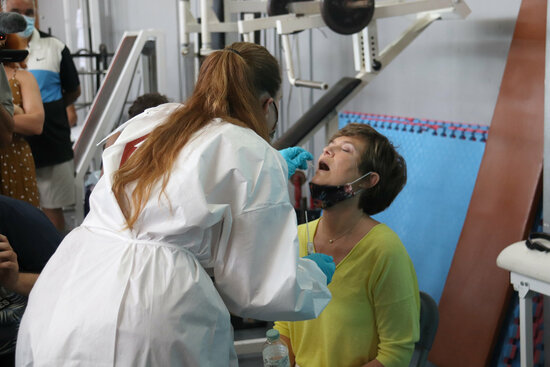Covid outbreak risk reaches highest levels since pandemic began
New confirmed cases continue to soar in latest update, with pressure on hospitals building

The risk of Covid-19 outbreaks is at its highest levels since the pandemic began, surpassing 1,000 in this indicator for the first time.
The figure now stands at 1,281, jumping 303 points in this pandemic indicator since the last update on Monday.
The outbreak risk has skyrocketed over the past fortnight or so, from 79 on June 18 - levels considered a ‘moderate’ risk.
For this indicator, above 100 is considered ‘high’ risk and authorities consider anything above 200 as ‘very high’ risk. It is calculated using an iEPG index - found by multiplying the average spread of the virus over the past seven days by the cumulative incidence over the past two weeks.
Newly confirmed cases have also seen huge surges since the beginning of last week, with over 30,000 new cases in the last week alone.
With 5,847 new positives reported for July 5 in the latest update, there have only been four other single days since the start of the pandemic with more new cases confirmed.
The transmission rate too has risen to 3.30, up from 2.99 on Monday, whereas the figure was below 1 as recently as June 20. This value represents the average number of times the virus will spread per Covid-19 patient.
The incidence rate over the past 14 days, which counts the number of confirmed cases per 100,000 population, has risen to 401.51. This figure has quadrupled in just over a week, as it stood at 98.77 on June 27.
Authorities considering new restrictions
The sharp rises in key indicators have led health authorities to consider applying new measures in order to curb the spread of the virus in Catalonia.
Catalan health minister Josep Maria Argimon described the situation faced by primary care centers as "very complicated."
"There is very significant pressure on medical centers because we have people who go to them with, for the most part, mild or very mild symptoms that still require care and tests," he explained. "And at the same time, the primary care system is carrying the entire weight of the vaccination campaign."
The huge spike in cases since the beginning of last week had not significantly affected hospitals at first, but the latest updates have begun to change this picture.
A further 102 people have hospitalized with the virus in the past three days, with the total number jumping from 473 to 575. However, this is still far below levels seen during the past months, when over 1,000 people needed medical care for Covid-19 in the first half of May, and the figure has, overall, been on a steady decline for months.
Additionally, the number of people in intensive care units is remaining stable, with 133 patients currently in ICUs - up from a low of 115 seen on July 1.
In the long-term, the state of this key pandemic indicator is also improving, with a steady decline in the count being seen ever since January, barring a brief uptick around Easter.
The health minister, who said clinical care protocols will be revised given the influx of young people with Covid-19 symptoms, maintained that the incidence rate "is very high" although "the perceived risk is low."
Speaking to Catalunya Ràdio on Monday morning, public health secretary Carmen Cabezas confirmed that authorities were considering further measures as well as health and safety guidelines, which will be put in place "if deemed necessary."
"We will make appropriate decisions when needed," Cabezas said.
And although the public health secretary acknowledged that people are not getting as ill as "a few months ago," she stressed that the state of the pandemic was still worrisome.
According to her, Catalan authorities cannot make face masks outdoors mandatory once again given the current legal framework regulating their use, but "insistently" encourages residents to wear them.
Protocol change for vaccinated close contacts
The Department of Health has changed the protocol for close contacts of Covid-19 positives.
Officials have decided that close contacts who are fully vaccinated should not be tested for the virus, whereas until now they would be tested via PCR or antigen testing.
It had already been established a few days ago that they should not be quarantined.
In addition, follow-up calls will be reduced, only made on the first day of quarantine, removing those on days 7 and 10.
Vaccination campaign
Health authorities insist that the perceived risk of the pandemic is overall quite low despite the rising case numbers and incidence rate largely thanks to the success of the vaccination campaign.
More than 40% of Catalonia’s population is already fully immunized, with either two doses of a jab that require it, one dose of the Janssen vaccine, or else one dose of another brand if the person has already had and recovered from the virus.
As of July 5, 2021, 4,366,745 residents have been given the first dose of the vaccine, 55.6% of the total population. Out of those, 2,904,709 have also been administered a second dose (37% of the total population).
3,225,089 residents are considered to be fully immunized (41.1%). Under 65s who have already had the virus are only required to have the first dose, and others have received a single-dose jab. Therefore, the % of two doses administered and % fully immunized do not match.
Number of people diagnosed per day
Hospitalized patients and ICU patients from July 29
Number of confirmed and suspected Covid-19 deaths per day (at hospitals until May 19, also other health centers from May 20, also elsewhere since August 5)
Outbreak risk (over 100 is high) and transmission rate (over 1 concerns authorities)
Number of cases per 100,000 inhabitants in last 14 days
Percentage of population vaccinated